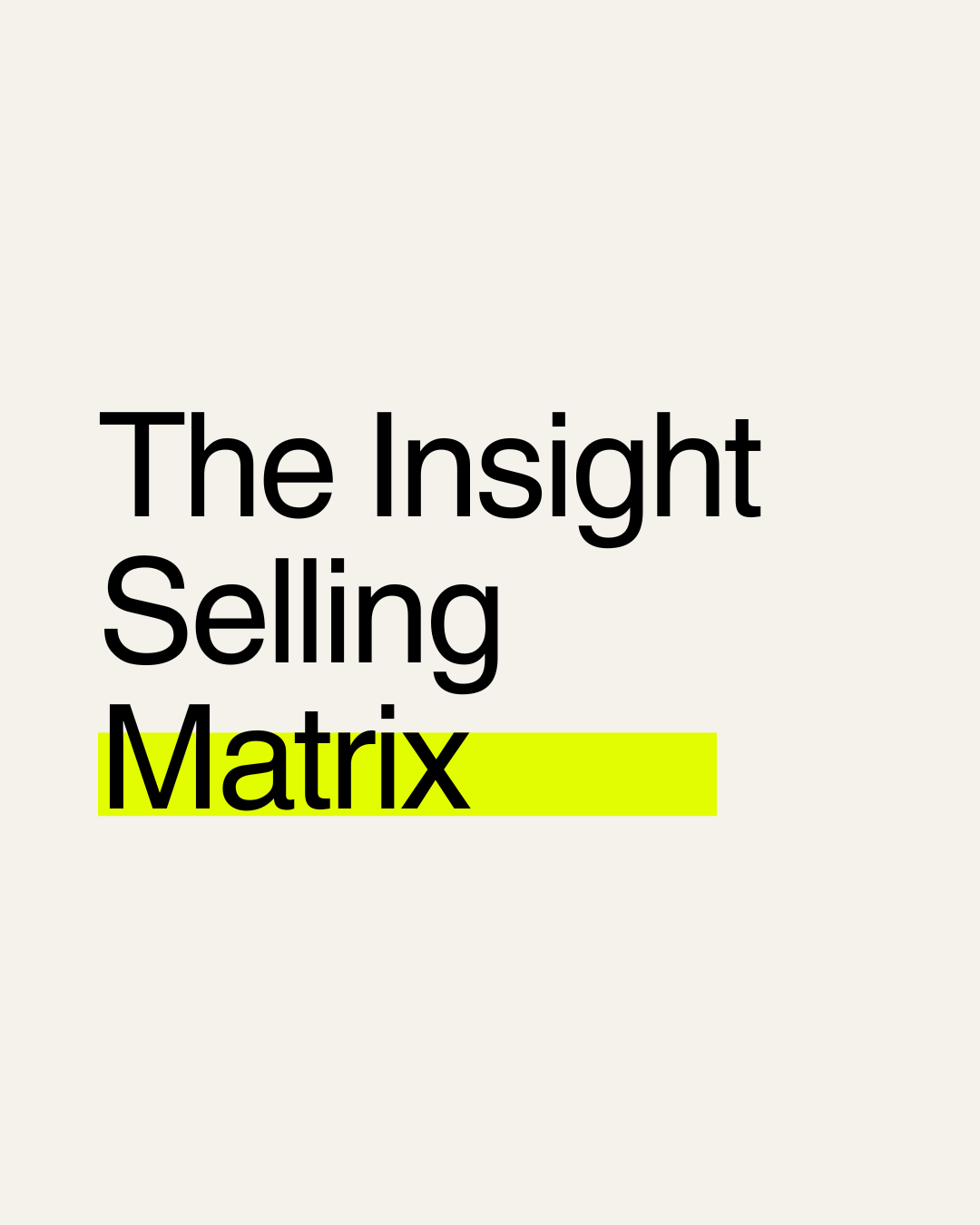The Insight Selling Matrix That Wins 50%+ More Competitive Deals
SAHIB'S NEWSLETTER
What you'll learn in this issue:
✓ Why feature comparisons kill your competitive advantage
✓ The 3-pillar framework that reframes entire buying decisions
✓ How one team turned a 28% competitive win rate into 73%
✓ Ready-to-use insight templates for immediate implementation
"We've decided to go with your competitor"
The words hung in the air as my client processed what had just happened. After three months of meetings, demos, and relationship-building, they'd lost a $250,000 deal to a solution that cost 40% more and delivered fewer features.
"I don't understand," the sales director said afterward. "We had better pricing, more functionality, and stronger references. How did we lose?"
It was a fundamental misunderstanding about how competitive sales are really won and led to a framework that has since helped companies dramatically increase their win rates against established competitors.
The Fatal Flaw in Traditional Competitive Selling
Most sales teams approach competitive situations by:
Comparing features side-by-side
Highlighting their advantages
Pointing out competitor weaknesses
Competing on price or terms
This approach assumes buyers make rational, feature-based decisions. But research from shows that 94% of customers choose the supplier who helped them understand and navigate their decision - not who had the best product.
When you compete on features, you're fighting on a battlefield where you've already lost, because you're accepting the buyer's existing decision framework instead of reshaping it.
Case Study: How a Company Dominated Their Competitive Market
Marcus leads sales for a company, a cloud infrastructure provider competing against industry giants with deeper pockets and broader feature sets. Their competitive win rate was stuck at 28% they were winning only when price was the primary factor.
The Problem: This company was competing within their prospects' existing evaluation criteria rather than expanding their perspective on what successful implementation really required.
The Solution: We implemented the Insight Selling Matrix with three strategic pillars:
1. The Reframe Insight Instead of accepting the buyer's evaluation criteria, this company began reshaping how prospects thought about the decision itself:
"Most companies evaluate cloud platforms based on features and pricing, but our analysis of 200+ implementations shows that 73% of failures happen due to factors that never appear on comparison charts. The companies that succeed think about this decision differently from the beginning"
2. The Hidden Risk Insight Rather than defending against competitor advantages, they revealed risks in the buyer's current approach:
"When companies choose providers based primarily on feature count, they often overlook integration complexity. We've seen organizations spend 2.5x their planned budget on custom development because their 'feature-rich' solution couldn't adapt to their actual workflow requirements"
3. The Outcome Redefinition Insight They shifted the conversation from product capabilities to business outcomes:
"The real question isn't which platform has more features it's which approach gets you to full operational capability fastest while minimizing disruption to your existing processes. That requires a fundamentally different evaluation framework"
The Results:
Competitive win rate increased from 28% to 73%
Average deal size grew by 31%
Sales cycle shortened by 22 days
Customer satisfaction scores improved by 28%
The key breakthrough? This company stopped trying to win within the existing decision framework and started reshaping the framework itself
Three Ways to Implement the Insight Selling Matrix Today
1. Develop Your Reframe Insights
Create 2-3 insights that challenge how your prospects currently think about their problem or solution. Structure each as:
Common but flawed assumption
Data or experience that contradicts it
Better framework for thinking about the decision
Template: "Most [industry] companies approach [decision] by focusing on [common criteria], but our work with [number] organizations shows that [better approach] is actually what determines success"
2. Build Your Hidden Risk Library
Identify 3-5 risks that prospects don't typically consider but that you've observed in the market. For each risk:
Connect it to a common evaluation mistake
Provide specific examples or data
Position your solution as naturally avoiding this risk
Example: "Companies often choose based on upfront cost, but we've tracked implementation expenses across 150+ projects. The 'cheaper' solutions typically cost 40% more by month six due to unexpected integration requirements"
3. Create Your Outcome Redefinition Scripts
Shift conversations from product features to business results using this sequence:
Acknowledge the current evaluation approach
Introduce a broader success metric
Reframe the entire decision around that metric
Sample script: "I understand you're comparing platforms based on technical capabilities. The organizations that achieve the best results actually evaluate based on 'time to business impact' which includes factors most vendors never discuss"
The Psychology Behind Insight Selling
The Insight Selling Matrix works because it leverages three psychological principles:
Status Quo Bias Override: People resist changing their thinking, but when presented with compelling evidence that their current approach is flawed, they become motivated to find a better framework.
Expert Positioning: When you provide valuable insights about their industry or decision process, you're positioned as a trusted advisor rather than a vendor pushing a product.
Cognitive Restructuring: By changing how prospects think about their problem, you change their evaluation criteria often in ways that favor your unique strengths.
What's Next?
This week, identify your top competitor's apparent advantages. For each advantage, develop an insight that reframes why that advantage might actually be a disadvantage in certain contexts.
Your challenge: Use one Reframe Insight in your next competitive situation. Notice how it changes the conversation dynamic.
Next week: I'll reveal the "Value Stacking Sequence" that has helped companies increase deal sizes by an average of 35% without adding new products or services
Until then,
Sahib



